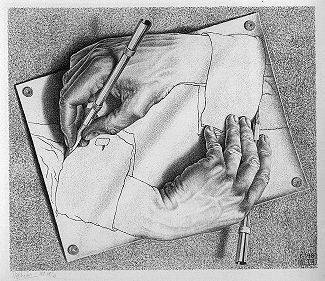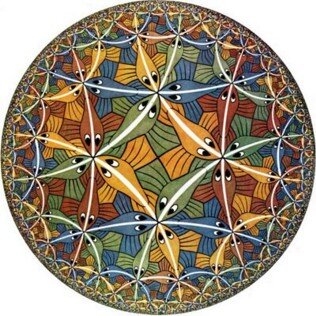THE PENROSE TRIANGLE
an intersection of physics, art and imagination
In a recent discussion about creativity, I told someone “I like to paint triangles.” After their natural amusement subsided, I assured them I was being serious. I am fond of triangles broadly, but my affection is strongest for a specific type of triangle called the Penrose Triangle. For me, the Penrose Triangle symbolizes humanities exploration of science and displays the value and appreciation we have for creative expression. As curious creatures, we’re constantly wandering and wondering. The difficulty with communicating our discoveries often increases with the complexity of the idea. In this post, I want to highlight how theory and physics merged with art to create a meaningful and timeless symbol that still evokes the imagination.
I like to paint these triangles with abstract backgrounds to participate in this conversation. I think these art pieces make for bold and stunning wall art, and like the Penrose Triangle itself, is an invitation to conversations about the mysteries of existence.
Namesake
The Penrose triangle is an “impossible shape” popularized by psychiatrist Lionel Penrose and his son, prominent Nobel Prize-winning mathematician Sir Roger Penrose. Although invention is credited to Swedish artist Oscar Reutersvärd, the shape is named for Penrose due to the popularity of it’s usage in the 1950’s.
Sir Roger Penrose is a fascinating person known for his research in cosmology, general relativity and (more recently) “the hard problem” of consciousness. He is half recipient of the 2020 Nobel Prize in Physics "for the discovery that black hole formation is a robust prediction of the general theory of relativity."
Why?
Penrose was seeking to exhibit plain sight impossibility to describe phenomena he was studying in the theory of general relativity and it’s application in black hole theory/cosmology. In 1954 Penrose happened across an exhibition of M.C. Escher in Amsterdam. Impressed by Escher’s grasp on mathematics, and fascinated by his early illusions, Penrose and his father set to work on creating their own impossible shapes.
The Inspiration
M.C. Escher was a Dutch graphic artist famous for his mathematical inspired creations. His 1954 exhibition that inspired Penrose likely contained works like “Drawing Hands” and “Relativity” as seen below.
History
Lionel and Roger Penrose set out to create the Penrose Triangle and a set of looping stairs that infinitely rise and fall. Sketches were shared with M.C. Escher who went on to use the concepts of the Penrose Triangle to create his two most famous masterpieces. “Waterfall” is also sometimes referred to as the Perpetual Motion Machine as the flowing river that turns the waterwheel continues indefinitely. “Ascending and Descending” builds on the Penrose stair concept where users could walk up or down the stairs continually, forever.
Extra Credit
Roger Penrose often uses another M.C. Escher drawing to exhibit the properties of infinity and circular edge theory. “Circle Limit IV” is a tessellation construct showing angels and devils converging on the outer limits of their bounds. Penrose uses this analogy to describe the behavior of our universe using conformal compaction (Conformal Field Theory). From what I understand, Circle Limit III and IV were woodcut, which goes on to describe the level of talent and forsight of M.C. Escher.









